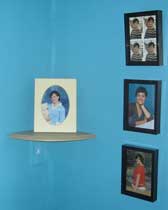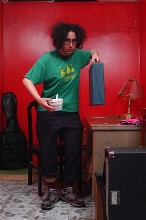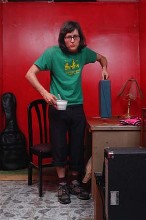(Part 3 of Jennifer Zarro’s interview with artist Liz Rywelski. Here is part 1) and part 2.)

JZ: Can you describe how your Kmart Series of photographs came about (image a K-Mart Series installation detail at Joymore Gallery in Brooklyn)?
LR: I can attribute two specific events to the conception of the Kmart Portraits.
In the spring of 2002, I took a trip from Philadelphia to Massapequa, Long Island, to visit my parents before my final year of college was over. While home, I found my grade school portraits. I lined them up in year order and saw how from nursery school to fifth grade the images were more portraits of my parents because they chose my clothes, hair cut, and the back-ground. I felt that those early year portraits were so precious because they were so much of my parents.
The later portraits were of me for sure, with curled bangs and polymer bead necklaces from the Busy-Bee Flea Market. I could see my hand in my self-expression. I wanted to remake those early pictures, the ones of my parents, as an art project. I thought about how to do that for a while.
During my final year of college, I lived with my best friend, Kelli. Kelli is the most striking, statuesque, beautiful woman. Everyone we met wanted to know more about her, and collaborate artistically with her in some way. This made me very jealous at the time. Every photographer we knew was asking to take her picture. I wanted to have interesting people be interested in me too and take photos of me. It was driving me crazy and, in small ways, probably making me a bad friend.
To make it up to her I thought it would be funny to go to OlanMills to have photos taken of me. I went OlanMills because it was cheep, familiar to me, and because this was a joke so I knew it would be OK for this portrait to have a kitschy look. So one hot May day I went to Wawa, got $100 out of my bank account, went to the free library, looked up SEPTA schedules and the nearest OlanMills studio, walked to 8th Street and took the bus down to the Walt Whitman shopping center on Oregon Ave. to go to Kmart [in Philadelphia].
I walked into Kmart without a plan and walked around to see who was working there and found this girl named Lyn, she was about 27, pretty and young, and wore khaki pants with a sheer black shirt and a gold belt and her name tag. I asked her to help me find clothes and she was happy to do so. I told her I was getting my portrait taken for my family who I have not seen in five years and that I was just about to graduate college. I did not tell her what I studied or where my family lives. She picked out my clothes and I told her I only had $100 dollars to spend. I tried them on she said I looked great but needed a belt and left for a minute to get one. The belt she chose was the same one she was wearing.
I thanked her and went to get some make-up. I did the same thing in the cosmetics department: went to see who was working there and told her the same story about graduating and my family, and also told her that I do not really wear makeup that much and would not know where to start. She was also very happy to help me and proceeded to choose for me the very same brand and color makeup she was wearing on her face. She was over 55 for sure.
Before I bought everything, I went to back to Lyn and asked her how she thought I should wear my hair. She thought I should pin it to the side and I did. I bought all of the clothes and makeup, and went to the fitting room to put on this outfit. I asked the dressing room attendant if I looked OK; she told me to tuck in my shirt.
I then went to the OlanMills studio. Laquisha was my photographer. She was in her early 20’s. I told her about graduating and my family. She set me up in five poses.
When the pictures were done, I went back to the dressing room and took off all of the clothes and packed up the makeup. I went to the customer service desk and returned everything I had bought, no questions asked. The woman at customer service gave me a Kmart gift card in place of cash. I decided that if I ever do this again this would be the $100 that I use.
Anyone who has ever been to OlanMills knows that when you go back to get the portraits they try to sell you a bunch of portraits after the package deal. When looking through all of the prints, I choose one image that best described my experience. This is when I first saw this as an artwork. I realized the possibilities in having so many images of myself in outfits picked by random, unsuspecting people. That is when I realized this is how I would go about remaking those early childhood portraits.
The project has evolved over the last three years and it has not yet completed itself because I am not yet done collecting images. It has grown to be about so many things already. For me, as the artist collecting the portraits, it has not been about judgment or laying judgment on those who end up participating in each portrait. It has not been about class or inequality, which I have been accused of. It has been about who we are right now and what we look like right now and how another person’s idea can alter that.
More images of the Kmart Series are here.

For images from the Red Room Series, in which Rywelski poses in others’ clothes, right down to their underwear, go here (image above, Damon posing for the Red Room Series, and image below, Liz posing in Damon’s clothes).
JZ: A lot of your work such as the Kmart Series and the Red Room Series deal with taking on and documenting yourself in different identities and in different guises. Some people have compared you to Cindy Sherman, who explores roles and stereotypes of women in society, but you seem to be exploring a personal metamorphosis and how others can influence your identity at any given time.
LR: The project has been about offering myself up to other people’s ideas for me and documenting it. This is very different from what Cindy Sherman does. Her hand is in everything you see in her pieces. She has a perception of one kind or one type of woman and remakes herself in that perception. And in doing this, she provides the viewer with a translation.

I do none of this. My hand is nowhere to be seen in these images. When working with the Olan Mills photographer I try to take on their enthusiasm or lack of. I try to give back to the camera what they give to me. So when people mention Cindy Sherman, I think that is a very simple comparison, but incomparable if you do the math
JZ: You have received so much attention for the Kmart series. It seems you touched on something and people are really responding favorably. Are you surprised by this?
LR: Yes, I was very surprised and excited by it when the project first gained attention. However, at the same time, I don’t really know of anyone else who is making the kind of work I am making, so I thought this project was filling a need or a gap in our local art community, and that might be part of why I get the attention I do.
I showed the project at Fleisher/Ollman gallery’s first invitational, The New Acropolis. I applied to Arcadia University Gallery’s juried exhibition and I was chosen to be in Works On Paper 2004 show curated by Jordan Kantor. From there, the project picked up attention with a few magazine interviews.
It felt good, but at the same time I was wrapped up in what others were seeing in my work and sort of lost touch with my original thoughts. Budget Living called me a performance artist in their article. I thought that was a huge thing. How often does the phrase “Performance art” show up in a new homemaker’s magazine?
JZ: Are you a performance artist? Or is this kind of labeling too limiting for you and perhaps too old-fashioned these days?
LR:Perhaps. Things change as I reach my goals. I do not think about what it means to be a performance artist and fill that role. All of my work combines at least two mediums to create one final piece. I do what feels right, and often that involves documenting an interaction with unsuspecting others while just living my life. And all of my work is collaborative.
JZ: In the interview with Budget Living Magazine, regarding your Kmart Series, you said that you are not sure if you are just “messing with people or getting at something” with this project. How do you feel about that now?
LR:I gave that interview with Budget Living over the phone while I was in Cincinnati. This was before I had taken any portraits in that region. I am closer now. I do these forced collaborations with women who really know their stuff. I mean, if you are a woman who has an interest in fashion or style taking a job in the clothing or cosmetics and jewelry departments at Kmart is a great job.
The women who help me hold years of life experience and knowledge of local or regional trends. They just give that to me because I ask for it. I am not messing with people; I don’t feel that way anymore. If anything, I am playing a secret game of dress-up on Kmart’s dollar for the greater good.









